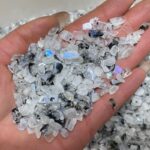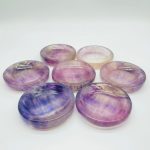Crystals are beautiful and fascinating natural formations that have captivated humans for centuries. They are found in a wide variety of colors, shapes, and sizes, and each type of crystal has its own unique properties and uses.

If you’re interested in learning more about crystals, the first step is to be able to recognize them. Here are a few tips on how to do just that:
1. Look at the shape
Crystals come in a wide variety of shapes, but some of the most common include:
- Cubic: These crystals have six square sides and eight corners. Examples include diamonds and fluorite.
- Hexagonal: These crystals have six sides that are equal in length and six corners. Examples include quartz and calcite.
- Trigonal: These crystals have three sides that are equal in length and three corners. Examples include amethyst and tourmaline.
- Tetragonal: These crystals have four sides that are equal in length and four corners. Examples include zircon and rutile.
- Orthorhombic: These crystals have three sides that are different in length and three corners. Examples include topaz and barite.
- Monoclinic: These crystals have two sides that are different in length and two corners. Examples include gypsum and orthoclase.
- Triclinic: These crystals have three sides that are all different in length and three corners. Examples include plagioclase feldspar and microcline.
2. Consider the color
Crystals come in a wide range of colors, but some of the most common include:
- Clear: These crystals are transparent and allow light to pass through them. Examples include quartz and calcite.
- White: These crystals are opaque and reflect light. Examples include marble and chalk.
- Black: These crystals absorb light and do not reflect it. Examples include obsidian and jet.
- Red: These crystals are caused by the presence of iron or manganese. Examples include garnet and ruby.
- Green: These crystals are caused by the presence of chromium or copper. Examples include emerald and malachite.
- Blue: These crystals are caused by the presence of cobalt or copper. Examples include sapphire and lapis lazuli.
- Purple: These crystals are caused by the presence of manganese or iron. Examples include amethyst and fluorite.
3. Feel the weight
Crystals vary in weight depending on their density. Some of the lightest crystals include quartz and calcite, while some of the heaviest crystals include pyrite and galena.
4. Test the hardness
Crystals also vary in hardness. Some of the softest crystals include talc and gypsum, while some of the hardest crystals include diamond and corundum.
5. Consider the luster
Crystals have a variety of different lusters, including:
- Vitreous: These crystals have a glassy luster. Examples include quartz and calcite.
- Adamantine: These crystals have a diamond-like luster. Examples include diamond and cubic zirconia.
- Metallic: These crystals have a metallic luster. Examples include pyrite and galena.
- Pearly: These crystals have a pearly luster. Examples include mother-of-pearl and abalone.
- Greasy: These crystals have a greasy luster. Examples include talc and serpentine.
- Earthy: These crystals have a dull luster. Examples include chalk and clay.
Other useful information
In addition to the physical properties listed above, crystals can also be identified by their chemical composition and crystal structure. However, these methods are more complex and require specialized equipment.
If you’re not sure whether or not a particular specimen is a crystal, you can always consult with a geologist or other expert.
| Shape | Example |
|---|---|
| Cubic | Diamond, fluorite |
| Hexagonal | Quartz, calcite |
| Trigonal | Amethyst, tourmaline |
| Tetragonal | Zircon, rutile |
| Orthorhombic | Topaz, barite |
| Monoclinic | Gypsum, orthoclase |
| Triclinic | Plagioclase feldspar, microcline |
| Color | Cause | Example |
|---|---|---|
| Clear | No impurities | Quartz, calcite |
| White | Tiny air bubbles or other inclusions | Marble, chalk |
| Black | Impurities such as carbon or iron | Obsidian, jet |
| Red | Iron or manganese | Garnet, ruby |
| Green | Chromium or copper | Emerald, malachite |
| Blue | Cobalt or copper | Sapphire, lapis lazuli |
| Purple | Manganese or iron | Amethyst, fluorite |
| Hardness | Example |
|---|---|
| 1 | Talc |
| 2 | Gypsum |
| 3 | Calcite |
| 4 | Fluorite |
| 5 | Apatite |
| 6 | Orthoclase |
| 7 | Quartz |
| 8 | Topaz |
| 9 | Corundum |
| 10 | Diamond |
| Luster | Example |
|---|---|
| Vitreous | Quartz, calcite |
| Adamantine | Diamond, cubic zirconia |
| Metallic | Pyrite, galena |
| Pearly | Mother-of-pearl, abalone |
| Greasy | Talc, serpentine |
| Earthy | Chalk, clay |
Conclusion
Crystals are beautiful and fascinating natural formations that can be found all over the world. By learning how to recognize crystals, you can appreciate their beauty and learn more about the natural world around you.




























